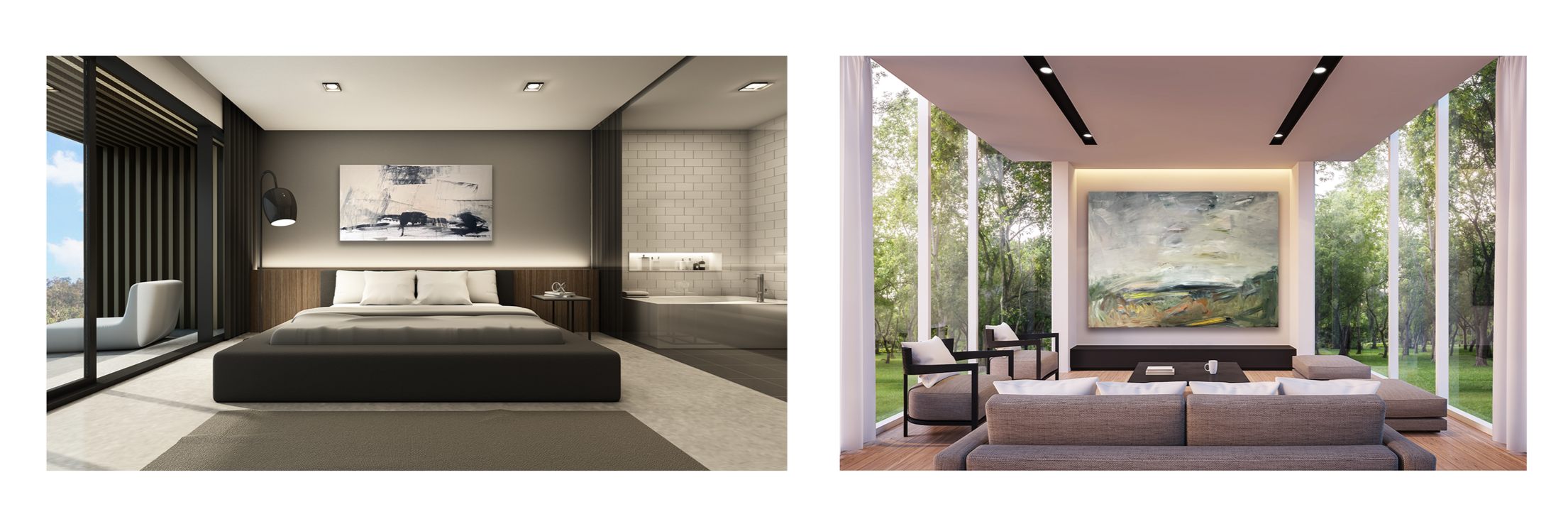Let There Be Light. How to Illuminate Your Artwork Beautifully
Art doesn’t just hang, it lives. And lighting is what breathes life into it.
Whether you’re placing a Bradford Brenner original in a quiet corner or making it the centerpiece of a room, the way you light it can transform how it’s felt, seen, and remembered.
Natural Light: A Living Dialogue
Natural light offers a dynamic relationship with art. As the sun shifts, so does the painting’s mood. Morning light might highlight soft brushwork, while afternoon sun deepens shadows and vibrancy. Tip: Indirect light from north-facing windows is ideal. Avoid direct sun to prevent fading.
Standard Recommendation for Lighting Artwork
2700K–3000K is considered the gold standard for picture lighting in homes and galleries.
Why 3000K Is the Sweet Spot?
Bradford prefers 3000K LED lighting—and for good reason. It offers a warm white glow that feels inviting while keeping colors true to life.
It’s less yellow than 2700K, but warmer and more intimate than cooler 4000K–5000K lights
It’s ideal for expressive, layered paintings like Brad’s, where mood and texture matter
It’s the standard recommendation for galleries and residential spaces2
Placement Tips for Taller Ceilings
For homes with 10–12 foot ceilings, aim for a 30–35° angle from the light source to the center of the artwork.
Example: If the artwork’s center is 5.5 feet from the floor, and the ceiling is 10 feet high, place the light about 3 feet out from the wall
This minimizes glare and shadows while enhancing depth and texture
What About Higher Color Temps?
4000K–5000K is often used in art studios or documentation settings where color accuracy is critical
These cooler lights can feel stark or overly bright in residential or gallery environments
5000K mimics daylight but may not suit the mood of expressive, layered paintings like Brad’s
Can Lighting: Sleek but Tricky
Recessed can lights work well if:
They’re adjustable
Installed at the right angle
Paired with the right beam spread (25–35°)
Here’s one we found on Amazon that 360° rotation + 90° tilt, that offers precise beam control for minimizing glare. Also, has a can-less design offering a sleek and low-profile, avoiding bulkiness.
Benefits of Underneath Lighting
Ambient glow: Creates a warm, inviting mood without overpowering the piece
Elegant framing: Visually “lifts” the artwork, drawing attention without harsh shadows
Modern aesthetic: Seamless integration into architectural features (like floating walls or recesses)
Considerations
Limited directional control: Unlike adjustable spotlights, underlighting doesn’t reveal texture as effectively
Works best with larger or high-mounted artwork: To ensure the light spreads evenly without cutting off the visual impact
Mood over precision: It’s more atmospheric than functional—great for enhancing vibe, less ideal for full color fidelity.
Brad’s Take on Picture Lights
Brad tends to avoid traditional picture lights mounted directly above the artwork.
They can cast shadows, look bulky, and distract from the piece
Instead, he prefers recessed or track lighting that blends into the space and lets the artwork breathe
Track Lighting: Flexible, Focused, and Gallery-Approved
Track lighting is a favorite in galleries for good reason. It’s versatile, precise, and unobtrusive. Whether you’re spotlighting a single piece or illuminating a full wall of work, track systems allow you to adjust beam angles, brightness, and placement with ease.
Why It Works for Art
Directional control: Track heads can be aimed exactly where you want them, ideal for highlighting texture and brushwork
Clean aesthetic: Modern track systems blend into ceilings and don’t compete visually with the artwork
Layered lighting: Combine with underlighting or ambient sources for depth and mood
Brad prefers fixtures that offer 3000K warm white light with a high CRI (90+), ensuring colors stay true and the atmosphere feels inviting. Adjustable gimbal heads are especially useful for minimizing glare and casting soft, even light across the canvas.
Placement Tip
For ceilings around 10–12 feet high, position track lights about 3 feet out from the wall and aim for a 30–35° angle to reduce shadows and enhance texture.
Gallery Tip: We found a great track lighting system here on Amazon:
000K LED bulbs included
MR16 GU10 base—ideal for gallery grade spotlights
350° horizontal + 90° vertical rotation
60° beam angle for focused illumination
Clean, minimal design with adjustable arms
Lighting isn’t just technical, it’s emotional. It’s the difference between seeing a painting and feeling it.
ABOUT THE AUTHOR & ARTIST: BRADFORD BRENNER
Born June 9th, 1959 in New York City, NY to art collector parents, Bradford Brenner has been a professional artist for the last 36 years. His work has been featured in numerous national art publications and can be found in private and corporate collections throughout the world. Brenner’s gallery and studio is located on the historic Plaza in Healdsburg, CA.
Brad received his education from both University of California, Santa Barbara and San Diego State. Receiving creative inspiration and ideas intuitively, his emotive imagery and loose brushstrokes reflect an instinctive and intuitive spirit. Collectors are drawn to the freedom and looseness that represents his unique style, and highly spontaneous rich, multi-layered works. Brenner draws upon a wealth of artistic influences, including his passion for and study of the Old Masters, the Impressionists, the Tonalists and the Abstract Expressionists to create a style that is uniquely his own.





